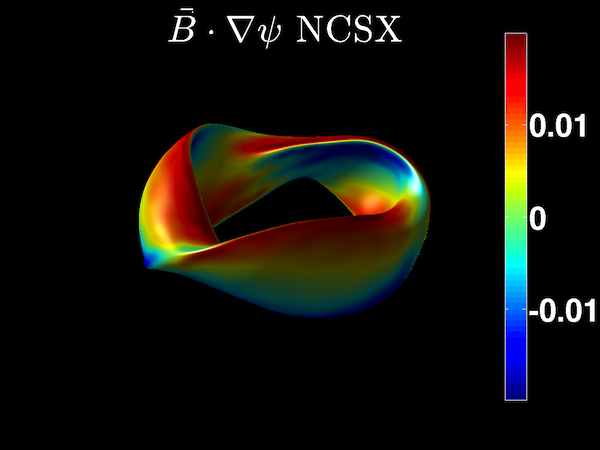BNORM

The BNORM code calculates the Fourier coefficients of the magnetic field normal to the VMEC surface.
\(\vec{B}\cdot\hat{n}=\frac{1}{4\pi}\int\frac{\vec{j}' dA}{\|\vec{x}-\vec{x}'\|^{3/2}}\)
It achieves this by utilizing the covariant magnetic field on the VMEC surface to construct a surface current. It creates input files for the NESCOIL program.
Theory
The purpose of this code is to calculate the Fourier components of outward normal components of the magnetic field. This information is passed to the NESCOIL routine. The code achieves this by first using the covariant magnetic field to construct a surface current density
\(\vec{K}=B_u \frac{\partial \vec{x}}{\partial v} - B_v \frac{\partial \vec{x}}{\partial u}.\)
This surface current is then used to construct the vector potential everywhere on VMEC surface. The calculation of the vector potential requires special treatment for singularities. At a given point x the vector potential due to all other points on the surface is calculated. Then a subroutine is called to handle contribution to the vector potential by the point x. The curl of this vector potential then provides the normal component of the magnetic field on the VMEC surface.
The code utlizes a normalization for total poloidal current CURPOL which is
\(I_{pol}=\frac{2\pi B_v\left(0,0\right)}{N_{per}}.\)
This normalization arrises from the deffinition of a wire and the vector identities. The field of a wire is:
\(B_{wire}=\frac{\mu_0 I_{pol}}{2\pi R}\)
and the deffinition of the toroidal field is:
\(B_\phi = RB^v = R \frac{B_v}{R^2} = \frac{B_v}{R}\)
Combining these deffinitions gives:
\(I_{pol} = \frac{2\pi B_v}{\mu_0} = \frac{CURPOL N_{per}}{\mu_0}\)
Compilation
BNORM is a component of the STELLOPT suite of codes.
Input Data Format
The BNORM code reads input parameters from command line. Here are the arguments list.
| index | argument | description |
|---|---|---|
| 1 | extension | VMEC ‘wout’ file |
| 2 | separation | [optional, default: RBC(1,0)] uniformly scale-up separation, unit: same as RBC |
| 3 | nu | [optional, default: 256] poloidal resolution for plasma surface |
| 4 | nv | [optional, default: 256] toroidal resolution for plasma surface per period |
| 5 | mf | [optional, default: 24] poloidal Fourier mode number for Bnormal distribution (mf>=MPOL-1) |
| 6 | nf | [optional, default: 14] toroidal Fourier mode number for Bnormal distribution (nf>=NTOR) |
| 7 | md | [optional, default: 24] poloidal Fourier mode number for surface and Bfield representations |
| 8 | nd | [optional, default: 20] toroidal Fourier mode number for surface and Bfield representations |
Execution
To run BNORM with a given input file simply pass the name of the VMEC output file to BNORM like so (input file named input.test):
xbnorm wout.test >& bnorm_log.test &
The code can take one optional parameter, the coil separation in generalized units.
xbnorm wout.test 0.3 >& bnorm_log.test &
You can also run BNORM with customized resolutions, like
xbnorm wout.test 0.3 128 128 16 8 8 8 >& bnorm_log.test &
Especially when the default Fourier resolutions are not large
enough. mf>=MPOL-1 and nf>=NTOR should be satisfied.
In the above commands, we’ve redirected screen output (trapping error messages) to ‘bnorm_log.test’ and put the process in the background.
Output Data Format
The BNORM code outputs two files the ‘bnorm.suffix’ file and ‘nescin.suffix’ file (where suffix is the suffix of the VMEC ‘wout’ file). The first file contains the Fourier coefficients of the normal B-Field. The second file is the input file for the NESCOIL code.
The ‘bnorm’ file has a list of the m, n, and bnormal (sine) Fourier coefficients. For information on the ‘nescin’ file please see the NESCOIL page.
Visualization
There are no specific routines to visualize the data in the ‘bnorm’ file. However, the matlabVMEC routines should allow a user to plot the values stored in the ‘bnorm’ file. The bnorm values are calculated from the covariant components of the magnetic field from VMEC. Thus, the Fourier coefficients should have the same parity (sine) as the covariant components.
Tutorials
NCSX BNORM Example Solovev BNORM Example